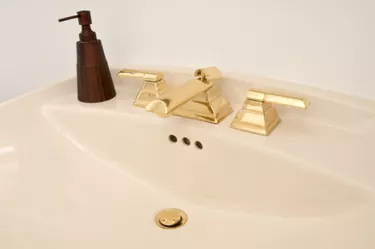
The sinks in the kitchen and bathroom are major accent points. Other than its beauty, the sink holds a valuable responsibility; it is the central location for cleaning dishes, washing faces and brushing your teeth. With the advancements in technology, your sink can look and run however you like. There are typically two types of sinks -- those with overflow prevention and those without overflow prevention. Each style of sink will require a particular sink drain, such as pop-up drain, grid drain or the traditional sink stopper.
Pop-up Sink Drains
Video of the Day
Pop-up sink drains are ideal for sinks used primarily for hand and face washing. Pop-up drains are designed without overflow prevention, allowing you to fill your sink completely. Therefore, running water should not be left unattended. Older model pop-up sink drains were designed with a device on the back of the sink that controls the drain. Newer model pop-up drains open and close by simply touching the drain.
Video of the Day
Grid Drains
Grid drains are a type of drain made for vessel sinks. A vessel sink is the traditional bowl-like sink found in most homes. Grid drains are not made to open and close; they let you continuously run water without the fear of overflow. Grid drains come in a variety of designs, but the traditional models have a series of connecting square spaces, giving the look of a grid.
Lift and Turn Sink Drains
Lift and turn sink drains are versatile; they can be used with a variety of sinks, including undermount, drop-in and vessel sinks, as well as sinks without overflow. Lift and turn drains lift to drain water and turn to hold water. A lift and turn drain is easy to install. It can be both removed and installed with only a flat-head screwdriver.
Sink Drain Stoppers
Sink drain stoppers are intended for sinks with no overflow. They were created so you could fill your sink with water for washing your face, hands or clothes. Stoppers come in a variety of designs and sizes. The most important aspect to remember when purchasing a stopper is the size of the drain hole you are trying to fit. Stoppers are designed to prevent the drainage of water; therefore, if the size of the stopper is off by a little, it will not work.